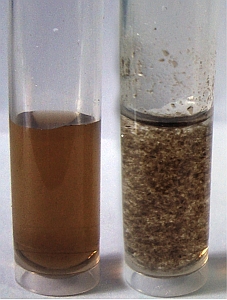
The vial at left holds microscopic particles of graphene oxide in a solution. At right, graphene oxide is added to simulated nuclear waste, which quickly clumps for easy removal. (Credit Anna Yu. Romanchuk/Lomonosov Moscow State University)
Researchers at Rice University in Houston and Lomonosov Moscow State University in Russia developed a lab process with graphene oxide to remove radioactive materials from contaminated water. The team from the labs of Rice chemistry professor James Tour and Moscow chemist Stepan Kalmykov published their findings in a recent issue of the journal Physical Chemistry Chemical Physics (paid subscription required).
Graphene oxide is a compound of graphene, a material closely related to graphite like that used in pencils, but consisting of a single layer of carbon atoms. The material is very light, strong, chemically stable, and can conduct both heat and electricity. The researchers tested the ability of graphene oxide flakes to bind to natural and human-made radionuclides and condense them into solids. Radionuclides are unstable metals, often occuring naturally, that decay and emit gamma or sub-atomic particle radiation.
Flakes made of graphene oxide are soluble in liquids, have a large surface area, and can be produced in bulk. The large surface area, say the researchers, give it the capacity to absorb toxins. The key question for the team, however, was how fast the graphene oxide flakes would work. Tour’s lab at Rice synthesized the graphene oxide, while Kalmykov’s group in Moscow conducted the tests with simulated nuclear wastes: uranium, plutonium, and substances like sodium and calcium that could negatively affect their adsorption.
The tests showed the graphene oxide flakes bind quickly to natural and human-made radionuclides and condense them into solids. The tests focused on radioactive isotopes of actinides and lanthanides, comprising 30 rare earth elements in the periodic table, in liquid solutions. The graphene oxide introduced to the simulated wastes coagulated within minutes, quickly clumping the worst toxins (see photo at top), and across a range of pH values.
Tour says the findings suggest the process can be applied to the clean-up of a number of radioactive and toxic materials from nuclear accidents and hydraulic fracturing. He cautions, however, capturing radionuclides does not make them less radioactive, just easier to handle. “Where you have huge pools of radioactive material, like at Fukushima, you add graphene oxide and get back a solid material from what were just ions in a solution,” says Tour. “Then you can skim it off and burn it. Graphene oxide burns very rapidly and leaves a cake of radioactive material you can then reuse.”
With hydraulic fracturing, Tour notes, the technique could offer a way of cleaning contaminated wastewater at the well, rather than shipping it to an offsite location for processing. “When groundwater comes out of a well and it’s radioactive above a certain level, they can’t put it back into the ground,” says Tour. “Companies have to ship contaminated water to repository sites around the country at very large expense.”
Read more:
- Process Developed to Grow Carbon Nanotubes on Graphene
- Rice, NIST to Partner on Nanoscale Carbon Materials Research
- Technique Devised for Controlling Graphene Nanopore Size
- Method Devised for Inexpensive Graphene Production
- Graphene as Rust-Proof Coating for Steel in Development
* * *

 RSS - Posts
RSS - Posts
You must be logged in to post a comment.